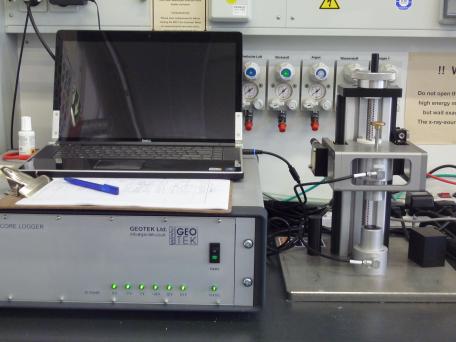Die Inhalte dieser Seite sind leider nicht auf Deutsch verfügbar.
Seitenpfad:
P-wave velocity
Measurements of P-wave velocity are made using a Geotek MSCL-DPW Discrete P-Wave measurement system, a benchtop system designed to measure compressional wave velocities through consolidated or lithified core sub-samples that can be either cubic or cylindrical in shape. Typically, these samples are taken at a frequency of one per section.
Calibration of the system is performed using a Delrin block of known dimensions and velocity. The separation between the transducers is calibrated using thicknesses of 40-90 mm, and checked with a 65 mm section. Delay is calculated automatically within the software and checked periodically by touching the two transducers together.
The MSCL-DPW system uses a vertically oriented transducer pair measuring at an acoustic signal of 230 kHz, and applying consistent sample pressure through use of a precision ball-screw system with internally detachable handle. Transmitter pulse level is adjustable from 0 to 250 volts, as is signal gain, ensuring a clear received signal. Ambient temperature and travel distance are automatically recorded using attached temperature probe and offset laser micrometer. High frequency analogue to digital conversion of the signal allows the seismic signal to be displayed through the software on a digital oscilloscope, with the first-arrival waveform automatically picked and velocity calculated. To improve the coupling between the transducer and sample, distilled water can applied to the solid neoprene transducer/receiver heads.
Measurements are performed first on samples dried in the oven for 24 h followed by measurement of the water-saturated sample. Saturation of pore spaces is achieved by placing the sample in a saline solution of 35 g/L ("seawater") for 24 h while in a vacuum.
Calibration of the system is performed using a Delrin block of known dimensions and velocity. The separation between the transducers is calibrated using thicknesses of 40-90 mm, and checked with a 65 mm section. Delay is calculated automatically within the software and checked periodically by touching the two transducers together.
The MSCL-DPW system uses a vertically oriented transducer pair measuring at an acoustic signal of 230 kHz, and applying consistent sample pressure through use of a precision ball-screw system with internally detachable handle. Transmitter pulse level is adjustable from 0 to 250 volts, as is signal gain, ensuring a clear received signal. Ambient temperature and travel distance are automatically recorded using attached temperature probe and offset laser micrometer. High frequency analogue to digital conversion of the signal allows the seismic signal to be displayed through the software on a digital oscilloscope, with the first-arrival waveform automatically picked and velocity calculated. To improve the coupling between the transducer and sample, distilled water can applied to the solid neoprene transducer/receiver heads.
Measurements are performed first on samples dried in the oven for 24 h followed by measurement of the water-saturated sample. Saturation of pore spaces is achieved by placing the sample in a saline solution of 35 g/L ("seawater") for 24 h while in a vacuum.



